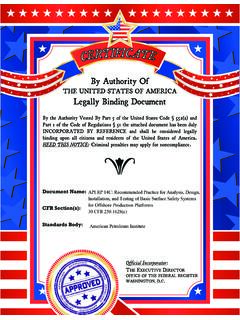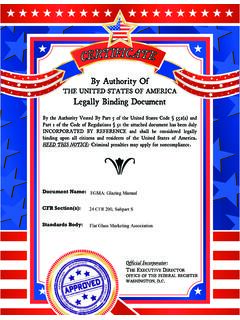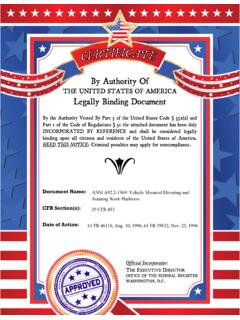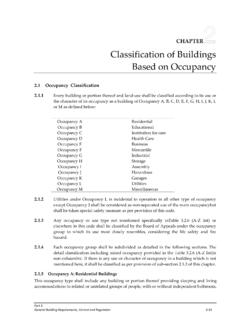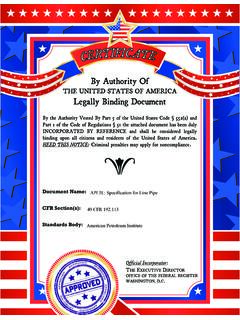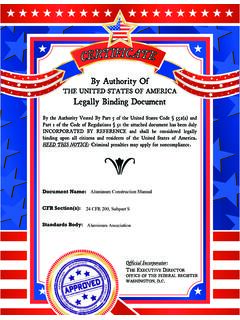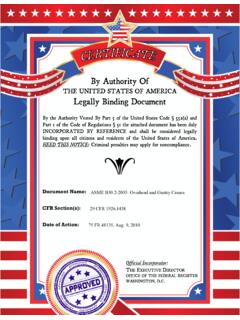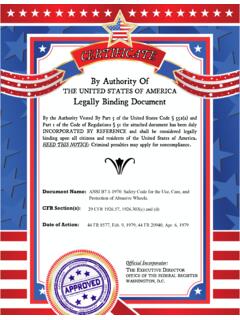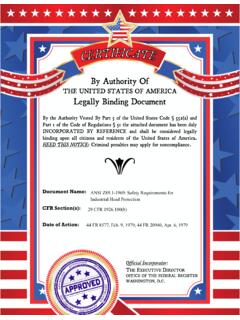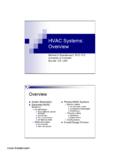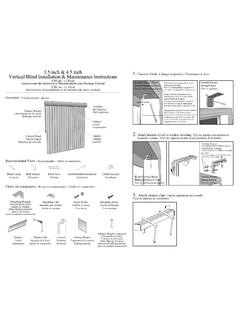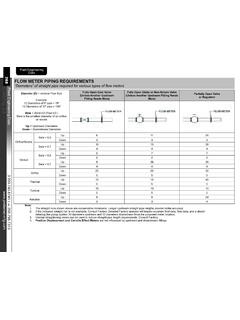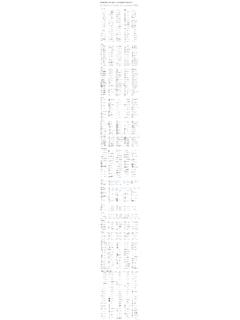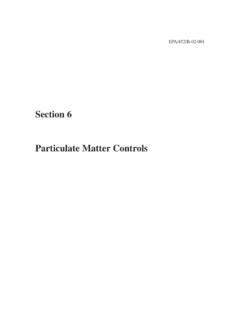Transcription of AMCA 210: Laboratory Methods of Testing Fans for Ratings
1 By Authority OfTHE UNITED STATES OF AMERICAL egally Binding DocumentBy the Authority Vested By Part 5 of the United States Code 552(a) and Part 1 of the Code of Regulations 51 the attached document has been duly INCORPORATED BY REFERENCE and shall be considered legally binding upon all citizens and residents of the United States of America. HEED THIS NOTICE: Criminal penalties may apply for noncompliance. Official Incorporator:THE EXECUTIVE DIRECTOROFFICE OF THE FEDERAL REGISTERWASHINGTON, Name: CFR Section(s): Standards Body: eAIR MOVEMENT AND CONTROL ASSOCIATION INTERNATIONAL, INC.
2 The International Authority on Air System Components ANSI/AMCA STANDARD 210 ANSIIASHRAE STANDARD 51 Laboratory METHOD OF Testing FANS FOR AERODYNAMIC PERFORMANCE RATING Published by Air Movement and Control Association International, Inc. and American Society of Heating, Refrigerating and Air Conditioning Engineers, Inc. 2000 By Air Movement and Control Association International, Inc. and American Society of Heating, Refrigerating and Air-Conditioning Engineers, Inc. All rights reserved. Reproduction or translation of any part of this work beyond that permitted by Sections 107 and 108 of the 1976 States Copyright Act without the permission of the copyright owner is unlawful.
3 Requests for permission or further information should be addressed to the Executive Vice President, Air Movement and Control Association International, Inc. at 30 West University Drive, Arlington Heights, Illinois, 60004-1893 USA - Fax: 847-253-0088 - E-mail: JOINT AMCA 210/ASHRAE 51 PROJECT COMMITTEE Robert Jorgensen, Chairman Steve Adamski Hoy R. Bohanon John Cermak Charles W. Coward, Jr. Daniel Fragnito Gerald P. Jolette John O'Connor t Paul R. Saxon James W. Schwier t Mark Stevens J. Thomas Sobieski William B.
4 Swim t deceased SPECIAL NOTE AMCA -ASHRAE AMCA -ASHRAE AMCA -ASHRAE AMCA -ASHRAE ASHRAE ASHRAE ASHRAE ASHRAE AMCA -ASHRAE AMCA -ASHRAE AMCA ASHRAE ASHRAE This National Voluntary Consensus Standard was developed under the joint auspices of the Air Movement and Control Association International, Inc. (AMCA) and the American Society of Heating, Refrigerating and Air-Conditioning Engineers, Inc. (ASHRAE). Consensus is defined as "substantial agreement reached by concerned interests according to the judgement of a duly appointed authority, after a concerted attempt at resolving objections.
5 Consensus implies much more than the concept of a simple majority but not necessarily unanimity." This definition is according to the American National Standards Institute (ANSI) of which both AMCA and ASHRAE are members. This Foreword is not a part of ANSI/AMCA Standard 210 or ANSIIASHRAE Standard 51 but is included for information purposes only. See also Appendix I for the History and Authority. FOREWORD This standard provides rules for Testing fans, under Laboratory conditions, to provide rating information.
6 It was prepared by a joint committee consisting of the Air Movement and Control Association International, Inc. (AMCA) 210 Review Committee and the American Society of Heating, Refrigerating and Air Conditioning Engineers, Inc. (ASHRAE) Standard 51-85R Committee. The joint committee debated whether the International Standard for Laboratory Testing of industrial fans, ISO 5801 Industrial fans: Performance Testing using standardised airways, should be adopted in lieu of preparing a new edition of this standard.
7 The decision to proceed with a ninth edition was based on the conclusion that ISO 5801 allowed the use of measurements that did not meet the uncertainties requirements of this standard. However, certain features ofISO 5801 have been included, most of which were anticipated in the 1985 edition. The principal changes compared to ANSI/AMCA 210-85//ANSIIASHRAE 51-85 Laboratory Methods of Testing Fans for Rating are: 1) Incorporation of SI units in the text. SI units are primary, I-P units ar_e secondary. 2) Addition of SI equations.
8 3) Numbering of equations for easier reference. 4) Deletion of tabular and graphical data as unnecessary, since equations are definitive and universal use of computers is anticipated. 5) Addition of Appendix F, giving an example of the iterative solution of Re and C. 6) Addition of Appendix I, giving the history of fan test codes in North America. Suggestions for improvement ofthis standard will be welcome. They should be sent to either the Air Movement and Control Association International, Inc., 30 West University Drive, Arlington Heights, Illinois 60004-1893 or the American Society of Heating, Refrigerating and Air Conditioning Engineers, Inc.
9 , 1791 Tullie Circle, , Atlanta, GA 30329 DISCLAIMER AMCA uses its best efforts to produce standards for the benefit of the industry and the public in light of available information and accepted industry practices. However, AMCA does not guarantee, certify or assure the safety of performance of any products, components or systems tested, designed, installed or operated in accordance with AMCA standards, or that any tests conducted under its standards will be non-hazardous or free from risk. ANSI/AMCA STANDARD 210 ANSIIASHRAE STANDARD 51 ANSI/AMCA STANDARD 210 ANSIIASHRAE STANDARD 51 CONTENTS ;ection Page 1.
10 Purpose .. 2. Scope .. 3. 1 1 Psychrometrics .. 1 Pressure .. 2 Fan Performance Variables.. 2 Miscellaneous .. 2 4. Symbols and Subscripts .. 4 Symbols and Subscripted Symbols .. 4 Additional Subscripts.. 5 5. Instruments and Methods of Measurement.. 5 Accuracy .. 5 Pressure .. 5 Airflow Rate .. 7 Power .. 8 8 Air Density.. 8 6. Equipment and Setups .. 9 Setups .. 9 9 10 Variable Supply and Exhaust Systems .. 10 7. Observations and Conduct of Test.. 11 General Test Requirement.
